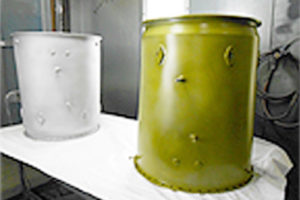Aware of Imagineering’s expertise in metal finishing, a client in the aerospace industry contacted us to apply a ceramic composite coating for their alloy steel aircraft engine components. We prepared the surface of the parts mechanically and chemically and applied the proprietary ceramic composite coating system and a corrosion protective aluminum-rich organic topcoat sealer. The coating was then heat cured at 1000¨¬F.
Needing to withstand high-temperatures and be anti-oxidizing and corrosion resistant, our thermally-fused ceramic composite coating was heat-oxidation resistance at temperatures of ¡Ã 1600¨¬ F. It combined thermal stability, excellent adhesion and hardness, good flexibility, and withstands high temperature cycling and corrosive salt environments. We verified the coatings by testing for thickness, curing, adhesion, and salt spray resistance. On this project we worked to tolerances of .0005″ and met various aerospace prime specifications.
This high-temperature corrosion resistant ceramic coating project showcased our ability to provide our client with high-quality components that exceed expectations. Please contact us to learn more about our products and services.

